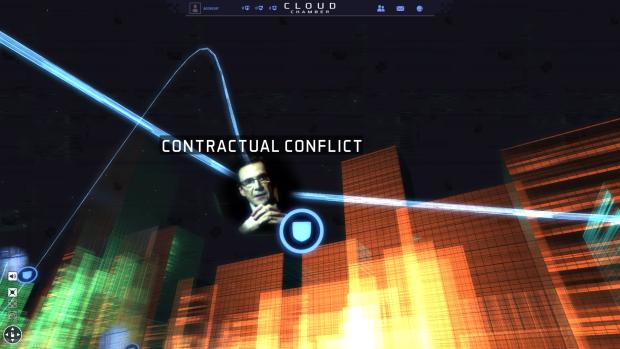I love game worlds that make me think about them, even when I’m not playing. Warcraft’s Azaroth is an absorbing landscape of details and tales. Dark Souls’ labyrinthine Lordran consumed my thoughts for more time than I care to admit. And Zelda’s Hyrule, its myths and legends, filled many a notebook back page on boring school days. I can now humbly add Cloud Chamber’s vision to that list.
And that’s a good thing too, because Cloud Chamber is all about the thinking. The game offers you the story of Ingrid Petterson, her daughter Kathleen, a filmmaker by the name of Thomas, a DJ called Max, a mysterious CEO rocking the moniker of Gustav, and more besides. Indeed to dwell on the game’s specific plot details would be both detrimental to your experience, and likely too telling of mine.
You see, Cloud Chamber isn’t a game is the traditional sense. There is no easy beginning, middle, and end to its structure. No easily defined conclusion, no direct interaction with its world, and no instant gratification for your actions. There is only you, information, your brain, and the other players. The entire point of Cloud Chamber is to sift through data files (videos, emails, text messages, notes, photos, etc) and try to make sense of everything that’s going on in your own head.

So if I was to tell you about the story I’d be giving you my interpretation, and I don’t want to do that. Safe to say there’s Kathleen, a young scientist who’s trying to understand more about the death of her mother, Ingrid, by conducting research into a mysterious ‘signal’, something her mother was very interested and involved in while she was still alive. This signal is something that may or may not have been the cause of her death. Something that may be alien, or from a parallel dimension, or just the pure embodiment of schizophrenia.
All of those things I mentioned about the signal are legitimate theories that I’ve read in Cloud Chamber, because everything you do in Cloud Chamber is peer assessed. Every file in the game has an attached message board, and it’s because of this that you can’t help but become absorbed. A ten second video clip becomes an hour of discussion as people pass on and discuss theories, point out miniscule details, and reference other files to spin their personal yarn.
It quickly becomes rabbit-hole stuff as you have commenters linking to outside journals, scientific theories and experiments that Cloud Chamber so openly references. You could just enjoy what’s here at a basic level, but if you have any inclination to really understand what’s going on, then you need to be ready to absorb some heavy information. I say this with absolute sincerity, you will definitely leave Cloud Chamber a more knowledgeable person than when you enter it.

What’s more, you need to discuss. Certain files will be locked off unless you earn some likes on a comment within the locked content’s particular ‘node’. It’s like if Facebook was a game, only here no-one’s going to like a post about Disney character personality tests, they only enjoy discourse concerning the possibility of black holes and alternate realities. So it’s actually more like an opposite-Facebook.
While this need to earn likes for your comments and theories does bring incredible satisfaction when you do get the recognition of Cloud Chamber’s other players, it does present one of the game’s few issues – play at certain times and you could find a comment sinking before many players get a chance to read it. It’s because of this that Cloud Chamber’s gameplay loop lacks the immediate gratification that is so often paramount in video game design, and this lack of reassurance is something that will be alien to pretty much every player. That said, the community seems strong enough that engaging in discussion with key commentators will earn you those much needed likes before too long, and there is so much content to consider that you can find more to investigate while you wait for interaction.
It’s annoying, ultimately, to say that the only glaring problem with Cloud Chamber is its ultimate reliance on you to find your own satisfaction, because in many ways this isn’t really an issue. Instead, this is liberating, and the fact that that Investigate North has the confidence to leave it up to the connected player base to come to their own conclusions about the information presented is an incredibly innovative and brave method of telling a story.

The piecemeal presentation is unique, too. This isn’t a movie, you don’t digest two hours of linear content and then make sense of that self-contained narrative. Cloud Chamber is a huge jigsaw that’s presented to you as if the pieces have been shaken out onto the floor, and left for you to sift between as you try and slot the jumbled mess back together.
And no, there’s no pop quiz at the conclusion. No scene with the game wrapping up its strings in a neat bow. No ‘yep, you got it right!’ slap on the back. It’s up to you, and if working out the Cloud Chamber mystery means that you’re reading about the Big Crunch and the Malthusian theory of Population at 1:30am, or getting an email to tell you that someone’s replied to one of your ideas while you’re trying to focus on scrubbing down the bath then so be it. This lack of clear “yes” moments are what makes the universe of Cloud Chamber both such a frightening a prospect, but also such an involving one in practise. More than the Warcrafts, the Dark Souls and the Hyrules, Cloud Chamber’s world and your interaction with it is the story, and that’s why it’s so intoxicating.
VERDICT: Not all of the acting is perfect, admittedly, and the audio presentation won’t be to everyone’s tastes, but when it works Cloud Chamber is an absorbing, massive, occasionally unsettling, but absolutely compelling experiment in community narrative investigation. It will require dedication and perseverance to enjoy fully, but don’t ignore it, Cloud Chamber is the most innovative slice of interactive storytelling in years.

SUPERB. This is the mark of greatness, only awarded to games that engage us from start to finish. Titles that score 9/10 will have very few problems or negative issues, and will deliver high quality and value for money across all aspects of their design.
Review code provided by publisher.





